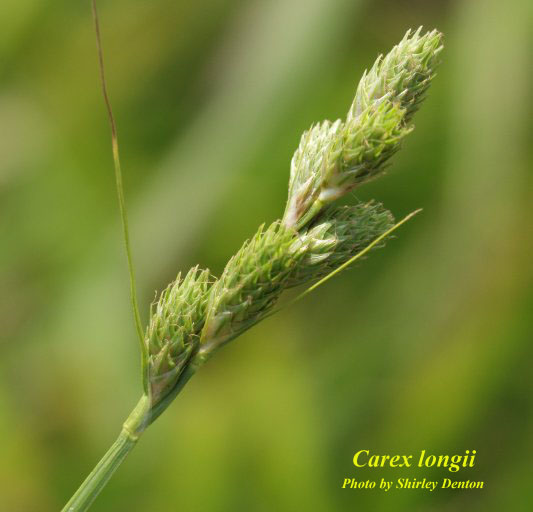Difference between revisions of "Carex longii"
| Line 1: | Line 1: | ||
{{italic title}} | {{italic title}} | ||
| − | Common names: Long's sedge <ref name= "USDA"> [https://plants.usda.gov/core/profile?symbol=CEAM USDA Plant Database]</ref> | + | Common names: Long's sedge <ref name= "USDA"> [https://plants.usda.gov/core/profile?symbol=CEAM USDA Plant Database]</ref> , Greenish-white Sedge <ref name= "Orzell">Orzell, S. L. and E. L. Bridges (2006). "Floristic composition of the south-central Florida dry prairie landscape." Florida Ecosystem 1(3): 123-133.</ref> |
<!-- Get the taxonomy information from the NRCS Plants database --> | <!-- Get the taxonomy information from the NRCS Plants database --> | ||
{{taxobox | {{taxobox | ||
Revision as of 15:37, 5 June 2018
Common names: Long's sedge [1] , Greenish-white Sedge [2]
| Carex longii | |
|---|---|

| |
| Photo by the Atlas of Florida Plants Database | |
| Scientific classification | |
| Kingdom: | Plantae |
| Division: | Magnoliophyta - Flowering plants |
| Class: | Liliopsida - Moncots |
| Order: | Cyperales |
| Family: | Cyperaceae |
| Genus: | Carex |
| Species: | C. longii |
| Binomial name | |
| Carex longii Mackenzie | |

| |
| Natural range of Carex longii from USDA NRCS Plants Database. | |
Contents
Taxonomic Notes
Synonyms: C. albolutescens
Varieties: none
Description
C. longii is a perennial graminoid of the Cyperaceae family native to North America. [1]
Distribution
C. longii is native to the eastern United States and up into eastern Canada, as well as the west coast of the United States. [1]
Ecology
Habitat
The C. longii is commonly found in marsh and other regions with moist soils. [3]
Phenology
C. longii commonly flowers from March to September with the most blooms occurring from April to June. [4]
Conservation and Management
Cultivation and restoration
Photo Gallery
References and notes
- ↑ 1.0 1.1 1.2 USDA Plant Database Cite error: Invalid
<ref>tag; name "USDA" defined multiple times with different content - ↑ Orzell, S. L. and E. L. Bridges (2006). "Floristic composition of the south-central Florida dry prairie landscape." Florida Ecosystem 1(3): 123-133.
- ↑ FSU Herbarium
- ↑ Pan Flora